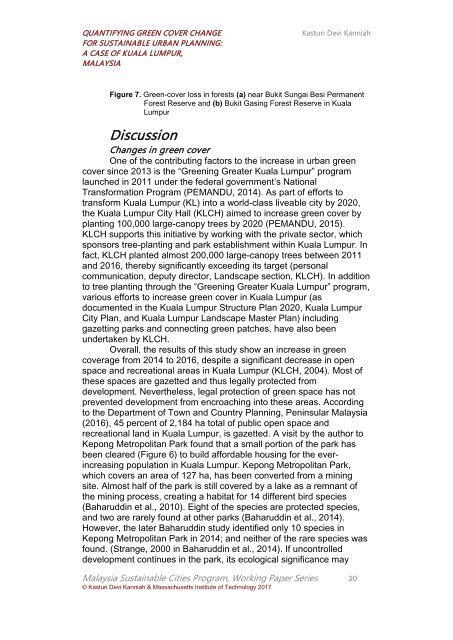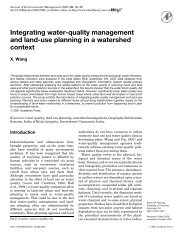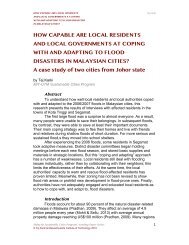Kanniah
Create successful ePaper yourself
Turn your PDF publications into a flip-book with our unique Google optimized e-Paper software.
QUANTIFYING GREEN COVER CHANGE<br />
FOR SUSTAINABLE URBAN PLANNING:<br />
A CASE OF KUALA LUMPUR,<br />
MALAYSIA<br />
Kasturi Devi <strong>Kanniah</strong><br />
Figure 7. Green-cover loss in forests (a) near Bukit Sungai Besi Permanent<br />
Forest Reserve and (b) Bukit Gasing Forest Reserve in Kuala<br />
Lumpur<br />
Discussion<br />
Changes in green cover<br />
One of the contributing factors to the increase in urban green<br />
cover since 2013 is the “Greening Greater Kuala Lumpur” program<br />
launched in 2011 under the federal government’s National<br />
Transformation Program (PEMANDU, 2014). As part of efforts to<br />
transform Kuala Lumpur (KL) into a world-class liveable city by 2020,<br />
the Kuala Lumpur City Hall (KLCH) aimed to increase green cover by<br />
planting 100,000 large-canopy trees by 2020 (PEMANDU, 2015).<br />
KLCH supports this initiative by working with the private sector, which<br />
sponsors tree-planting and park establishment within Kuala Lumpur. In<br />
fact, KLCH planted almost 200,000 large-canopy trees between 2011<br />
and 2016, thereby significantly exceeding its target (personal<br />
communication, deputy director, Landscape section, KLCH). In addition<br />
to tree planting through the “Greening Greater Kuala Lumpur” program,<br />
various efforts to increase green cover in Kuala Lumpur (as<br />
documented in the Kuala Lumpur Structure Plan 2020, Kuala Lumpur<br />
City Plan, and Kuala Lumpur Landscape Master Plan) including<br />
gazetting parks and connecting green patches, have also been<br />
undertaken by KLCH.<br />
Overall, the results of this study show an increase in green<br />
coverage from 2014 to 2016, despite a significant decrease in open<br />
space and recreational areas in Kuala Lumpur (KLCH, 2004). Most of<br />
these spaces are gazetted and thus legally protected from<br />
development. Nevertheless, legal protection of green space has not<br />
prevented development from encroaching into these areas. According<br />
to the Department of Town and Country Planning, Peninsular Malaysia<br />
(2016), 45 percent of 2,184 ha total of public open space and<br />
recreational land in Kuala Lumpur, is gazetted. A visit by the author to<br />
Kepong Metropolitan Park found that a small portion of the park has<br />
been cleared (Figure 6) to build affordable housing for the everincreasing<br />
population in Kuala Lumpur. Kepong Metropolitan Park,<br />
which covers an area of 127 ha, has been converted from a mining<br />
site. Almost half of the park is still covered by a lake as a remnant of<br />
the mining process, creating a habitat for 14 different bird species<br />
(Baharuddin et al., 2010). Eight of the species are protected species,<br />
and two are rarely found at other parks (Baharuddin et al., 2014).<br />
However, the later Baharuddin study identified only 10 species in<br />
Kepong Metropolitan Park in 2014; and neither of the rare species was<br />
found. (Strange, 2000 in Baharuddin et al., 2014). If uncontrolled<br />
development continues in the park, its ecological significance may<br />
Malaysia Sustainable Cities Program, Working Paper Series 20<br />
© Kasturi Devi <strong>Kanniah</strong> & Massachusetts Institute of Technology 2017






